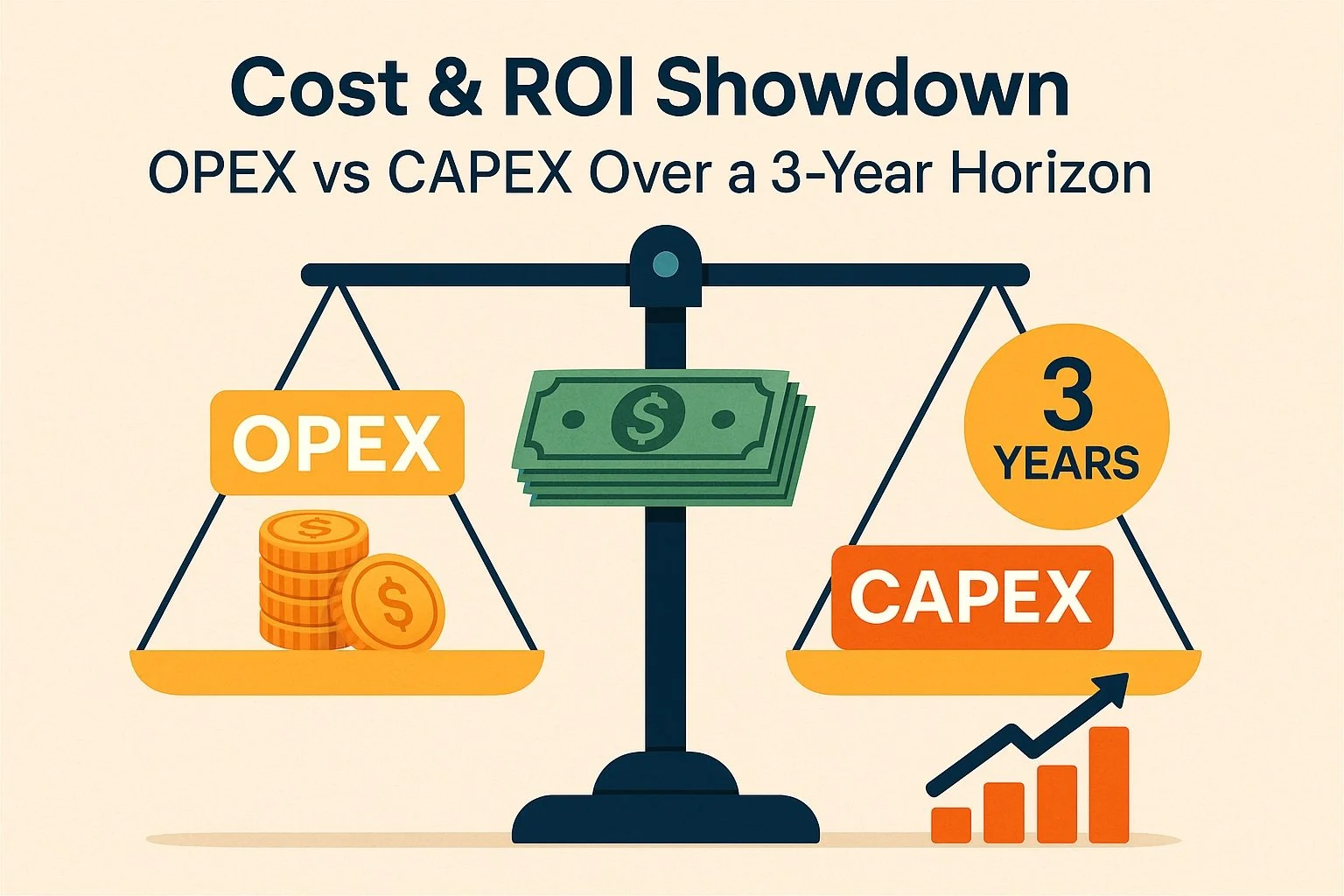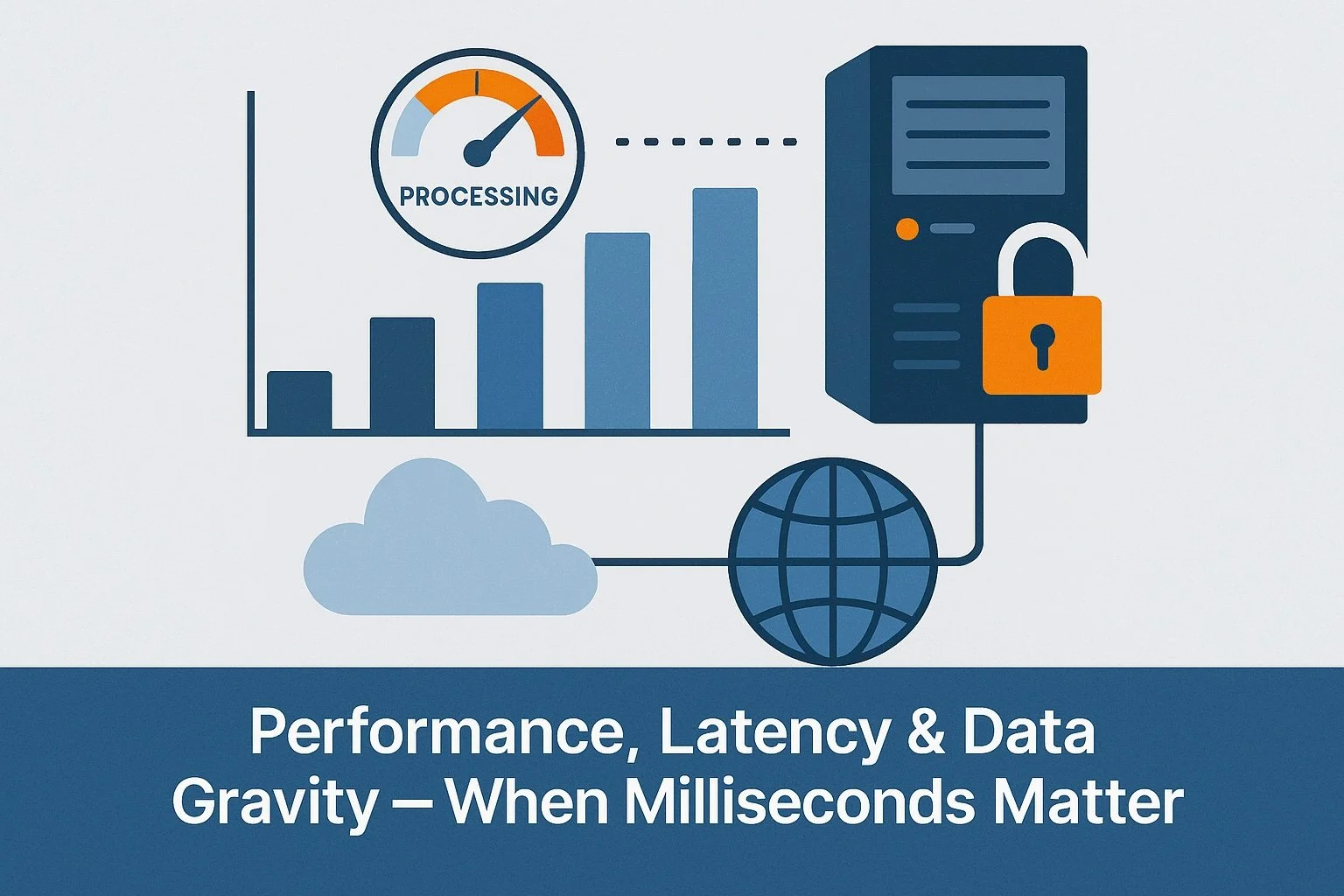Cloud vs On-Prem: Which Is the Right Choice?
Introduction — The 2025 Deployment Dilemma
In 2025, the decision between cloud and on-premises infrastructure has become more critical than ever — especially for organizations adopting AI-powered image processing at scale. For C-level executives, this choice is no longer just about IT architecture. It’s a strategic decision that directly impacts innovation velocity, cost structure, data governance, and customer experience.
With the rise of intelligent vision technologies — from automated document OCR to real-time product recognition and brand tracking — companies across sectors are embedding AI into core business processes. These capabilities can be delivered through cloud-native APIs, on-device inference, or hybrid systems that balance performance with privacy.
But which deployment model best aligns with your business goals?
Executives are increasingly faced with trade-offs like:
Speed vs Control: Do you need global scalability tomorrow or tighter control over sensitive data today?
CapEx vs OpEx: Is it better to invest upfront in local infrastructure or embrace pay-as-you-go flexibility?
Latency vs Bandwidth: Will your application suffer from round-trip delays, or can cloud latency be tolerated?
This post unpacks the strategic considerations behind each option, backed by real-world AI use cases — from e-commerce platforms applying background removal at scale to manufacturers detecting microscopic defects in real time. Along the way, we’ll explore the middle ground: hybrid deployments that maximize both agility and compliance.
Whether you're leading a digital transformation initiative, modernizing your IT portfolio, or exploring AI for operational efficiency, understanding the dynamics of cloud vs on-prem deployment is essential to ensuring long-term return on investment.
Let’s clarify the landscape — and help you choose the right path forward.
The Cloud Surge — Speed, Scale & Global Reach
For organizations aiming to innovate rapidly and deploy computer vision at scale, cloud infrastructure offers a powerful proposition. Over the past few years, cloud adoption has surged across industries — not just because it's technically convenient, but because it aligns with key business priorities: speed to market, scalability, cost agility, and global reach.
1. Accelerated Time-to-Value
Launching AI-powered image processing tools in the cloud requires no hardware provisioning or local infrastructure planning. Whether you're piloting a new product recommendation engine or rolling out facial recognition for user authentication, cloud-native APIs can be integrated and tested in days, not months.
Ready-to-use solutions — such as OCR APIs for extracting data from receipts or Background Removal APIs for e-commerce listings — can be instantly deployed via REST endpoints without building a model from scratch. This significantly lowers the barrier to entry and empowers business units to experiment and iterate faster.
2. Seamless Scalability for Dynamic Workloads
Cloud platforms are designed to handle variable demand. Retailers facing seasonal spikes, content platforms processing millions of images daily, or logistics firms tagging parcels in real time — all benefit from elastic compute resources. You pay for what you use, scale automatically, and avoid idle capacity that would otherwise drain ROI in on-prem systems.
This flexibility is particularly valuable when using APIs like Object Detection or Brand Mark Recognition, where workload volumes can vary dramatically based on campaign activity or user behavior.
3. Global Delivery, Minimal Latency
Cloud infrastructure provides geographic reach. With content delivery networks (CDNs) and distributed compute regions, companies can deliver AI experiences with sub-second latency across continents. This is especially useful for applications that serve international users — such as mobile apps using Car Background Removal or Wine Recognition APIs — where delays of even 500 milliseconds can degrade the user experience.
In a cloud setup, inference can happen near the end-user, reducing round-trip times and ensuring consistently responsive interactions.
4. Built-In Security and Compliance
Leading cloud providers offer enterprise-grade security and out-of-the-box compliance with major regulatory frameworks (e.g., ISO 27001, GDPR, SOC 2). This allows organizations to offload risk management to vendors with dedicated security teams and certified infrastructure — while still maintaining data protection standards.
For example, services like Image Anonymization APIs — useful for blurring faces in surveillance footage or protecting identities in legal documents — benefit from secure cloud handling with full audit trails and encryption protocols.
5. Predictable Operational Costs
Instead of capital-heavy purchases of GPU servers and maintenance overhead, cloud services operate on an operational expenditure (OpEx) model. This aligns well with modern budgeting practices, particularly for innovation-driven departments that prefer agile, cost-transparent models. APIs like Face Recognition or NSFW Classification can be billed by usage, allowing finance teams to forecast and control costs based on actual demand.
In summary, cloud deployment enables organizations to move faster, respond to change more flexibly, and reduce upfront risk — a compelling formula for any business looking to maintain competitive edge in today’s AI-driven landscape. While the cloud is not a one-size-fits-all solution, its benefits for speed, scale, and global access make it the default starting point for many forward-thinking enterprises.
The Resilience of On-Prem — Control, Compliance & Edge Efficiency
While the cloud offers undeniable agility, there are compelling reasons why many enterprises continue to invest in — or return to — on-premises infrastructure for their AI and computer vision workloads. For C-level executives managing highly regulated environments, latency-sensitive operations, or proprietary data, on-prem deployment remains a strategic advantage.
1. Full Control Over Data and Compute
On-prem systems offer complete ownership and control of both infrastructure and data. This is critical in sectors like healthcare, defense, and finance, where data sovereignty, IP sensitivity, or internal policy prevents outsourcing to third-party cloud vendors.
Imagine a legal-tech firm processing thousands of identity documents or a government agency applying facial recognition for security checks — storing this data on external servers could introduce unacceptable risk. With on-prem, data remains inside your secure perimeter, governed by your rules.
2. Compliance with Industry and Regional Regulations
In many industries, compliance isn’t optional — it’s mandatory. Medical institutions must adhere to HIPAA, EU-based entities face strict GDPR requirements, and manufacturers under NDA with global OEMs may be barred from using public clouds altogether.
Deploying computer vision capabilities — such as image labeling or brand detection — within your own data center ensures regulatory compliance without compromise. For global companies with diverse compliance obligations, on-prem provides a standardized and certifiable environment.
3. Superior Performance in Latency-Critical Scenarios
Some AI workloads demand millisecond-level responsiveness, where cloud round-trip times are a bottleneck. Consider:
An automotive plant running visual inspection for soldering defects on PCB boards.
A smart camera system identifying foreign objects on a high-speed conveyor belt.
In such cases, running inference locally — using models like YOLOv9 or PatchCore on GPUs embedded in industrial PCs — ensures consistent performance at 60–120 FPS, without dependency on network connectivity. APIs such as Object Detection or Defect Recognition can be packaged for on-prem execution in containerized environments when performance is mission-critical.
4. Cost Predictability at Scale
For companies with high and stable AI workloads, on-prem infrastructure can deliver cost efficiency in the long term. While upfront capital expenditures are significant (hardware, cooling, maintenance), the per-inference cost drops significantly as volume grows. This is especially relevant for enterprises that process millions of images monthly, such as logistics hubs or video-surveillance operations.
Additionally, on-prem removes variable costs like cloud egress fees, data transfer pricing, or unexpected overage charges — making long-term budgeting more predictable for CFOs.
5. Customization and Ecosystem Integration
On-prem environments can be highly customized to integrate with existing software, hardware, and automation pipelines. This enables tighter coupling between AI inference and operational systems, such as:
Integration with SCADA or MES systems on factory floors.
Real-time decision-making based on local camera inputs.
Offline processing where network access is intermittent.
For organizations with legacy systems or specialized hardware, cloud-based APIs may introduce integration friction — while local deployment ensures seamless interoperability.
In essence, on-prem deployment empowers enterprises with control, security, and precision — particularly where performance, compliance, and proprietary assets are non-negotiable. For C-level leaders, this model supports long-term resilience and strategic independence, even if it requires deeper initial investment and ongoing infrastructure stewardship.
And for businesses that still want the flexibility of APIs — such as OCR, Image Anonymization, or Custom Label Detection — providers that support both SaaS and on-prem deployment can deliver the best of both worlds.
Cost & ROI Showdown — OPEX vs CAPEX Over a 3-Year Horizon
For C-level executives, the decision between cloud and on-premises infrastructure isn’t just a technical one — it’s a financial strategy. It affects how capital is allocated, how quickly innovation can scale, and how predictable long-term expenses are. To choose wisely, you need to go beyond headline pricing and evaluate the total cost of ownership (TCO) and return on investment (ROI) over a multi-year horizon.
Cloud: Pay-as-You-Go Flexibility
Cloud services operate on an operational expenditure (OPEX) model. You pay only for what you use — compute power, storage, bandwidth, and API calls. There’s no upfront investment, no hardware to purchase, and no infrastructure to manage. This model is particularly appealing for teams launching new services or exploring experimental features.
For instance, a company building an AI-powered document intake system can integrate a ready-made OCR API and have it running in production in days. If the project gains traction, it scales automatically. If it doesn’t, the financial exposure is minimal. This elasticity allows for fast iteration and supports innovation without locking up capital.
The cost structure also aligns well with product lifecycles and marketing campaigns. Need to process 3 million product images during a holiday sale? The cloud scales instantly. Once the demand drops, so does your cost. This adaptability makes cloud services ideal for businesses with fluctuating workloads or rapidly changing requirements.
On-Prem: Investment for Long-Term Control
On-premises infrastructure, on the other hand, is a capital expenditure (CAPEX). It requires a significant upfront investment — servers, GPUs, storage arrays, cooling systems, and skilled personnel to manage it all. But for organizations with consistent, high-volume workloads, this investment can pay off over time.
Once deployed, on-prem systems provide stable, predictable costs. You’re not paying for every API call or data transfer — the infrastructure is yours. If you're processing millions of images monthly for quality inspection or brand detection, running models locally may significantly reduce your per-inference cost after the first year.
Additionally, on-prem infrastructure removes risks associated with bandwidth overuse, data egress fees, or sudden price changes by third-party providers. For heavily regulated sectors, or where data cannot legally leave the premises, this control becomes both a compliance necessity and a financial advantage.
Unseen Costs and Strategic Trade-offs
Both deployment models carry hidden financial implications that often go unnoticed until too late.
With cloud deployments, overuse, misconfigured autoscaling, or unmonitored storage growth can lead to unexpected spikes in monthly bills. Data-intensive operations — like processing gigabytes of video frames for object detection or face anonymization — can also incur significant costs due to network bandwidth and storage.
On-prem solutions come with their own challenges. Unused capacity during slower business cycles still incurs full operational costs. Hardware becomes obsolete quickly, and maintenance, upgrades, and energy bills persist regardless of utilization. Scaling on-prem capacity can take weeks or months, limiting your ability to respond to surging demand.
A Strategic Approach to Cost Efficiency
There is no universal winner. The right financial model depends on your business’s pace of growth, operational complexity, and tolerance for variable costs.
Startups and fast-moving product teams often benefit from the cloud’s low barrier to entry and flexible billing. Enterprises with stable, high-throughput computer vision workloads — like continuous video surveillance or industrial defect detection — may find on-prem infrastructure to be more cost-effective in the long run.
Increasingly, organizations are combining both models. For example, cloud APIs (such as image labeling or alcohol label recognition) can be used to power customer-facing features, while sensitive or high-frequency tasks — like face recognition on private video feeds — run locally for cost and compliance reasons.
Executive Takeaway
From a leadership perspective, this is not a binary choice between two technologies. It’s a business model decision with financial consequences that will be felt across operations, R&D, and the bottom line. Smart infrastructure planning means evaluating current needs and future growth, factoring in not just the cost of compute but the cost of innovation, compliance, and speed.
Ultimately, the most competitive organizations are those that treat infrastructure as a strategic asset — choosing cloud, on-prem, or a hybrid of both based on what delivers the greatest value, flexibility, and ROI over time.
Performance, Latency & Data Gravity — When Milliseconds Matter
For AI-powered systems — particularly those involving real-time image processing — performance and latency are not just technical metrics; they are business-critical variables. In fields like retail personalization, industrial inspection, and user-generated content moderation, delays of even a few hundred milliseconds can degrade customer experience, compromise safety, or reduce operational efficiency.
C-level executives need to evaluate how deployment choices affect not just system throughput, but the broader business outcomes tied to speed, responsiveness, and data accessibility.
Why Latency Matters
Latency — the time it takes for data to travel to a server, be processed, and return — has direct implications for user satisfaction and system responsiveness. In cloud environments, latency is often influenced by geographic distance, network congestion, and the availability of compute resources.
Consider a mobile app that uses background removal or facial recognition to let users try on sunglasses in augmented reality. If each image must travel to a cloud server and back before rendering, even a 600ms delay can make the interaction feel sluggish and break user engagement. For applications like this, low-latency inference is not optional — it's part of the product's value proposition.
On the flip side, applications such as automated image labeling for offline content or document OCR for batch processing may tolerate higher latency, making the cloud a viable and cost-effective choice.
The Cold Start Problem
Cloud environments, especially those built on serverless or containerized architectures, often experience what’s known as a cold start — a short delay that occurs when services spin up for the first time or after a period of inactivity. While this might only be a few seconds, it becomes significant in user-facing applications where expectations are high.
By contrast, on-prem systems or edge devices maintain persistent, always-on inference. For real-time decision-making — such as object detection in a manufacturing line or anonymization of live video feeds — eliminating cold starts ensures smooth and uninterrupted operation.
Data Gravity and the Cost of Movement
As AI workloads grow, so does the volume of data they generate and rely on. Terabytes of images, video streams, and sensor logs accumulate quickly — and where that data resides starts to shape infrastructure decisions.
This phenomenon is known as data gravity: when data is large and frequently accessed, it becomes more efficient to bring compute to the data rather than move data to the compute. For example, if your organization has petabytes of high-resolution imagery stored in a private datacenter, uploading it regularly to the cloud for processing can lead to:
High network costs
Latency from transfer time
Increased risk of data exposure
In these scenarios, on-prem or hybrid deployments — where models such as PatchCore for defect detection or YOLOv9 for object tracking run locally — offer better performance and lower cost.
Hybrid Approaches to Performance Optimization
Modern infrastructure strategies increasingly embrace hybrid models to balance latency and throughput:
Use cloud APIs for lightweight, latency-tolerant tasks (e.g., preview generation via an object detection API).
Process high-resolution or privacy-sensitive content locally to avoid transfer delays.
Deploy containerized versions of AI models at the edge for tasks requiring consistent sub-100ms responses.
This approach is particularly effective in environments like retail, where in-store cameras can perform local face anonymization while sending metadata to the cloud for centralized analytics and business intelligence.
Executive Insight
From a strategic standpoint, performance is not just about speed — it's about aligning technology with business context. A delay that seems minor on paper could mean lost conversions, bottlenecks in production, or compliance failures in regulated environments.
For C-suite leaders, this means asking the right questions:
What are the latency requirements of our core AI-enabled experiences?
Where does our data live — and how much does it cost to move it?
How do we ensure consistency in system behavior, even during traffic spikes?
When milliseconds matter, deployment strategy becomes a competitive differentiator. Companies that architect for performance — with the right mix of cloud, edge, and on-prem — can unlock smoother experiences, tighter control, and higher customer satisfaction across every AI touchpoint.
Decision Matrix — Six Criteria to Weigh & Hybrid Blueprints
For executives steering AI strategy, choosing between cloud, on-premises, or hybrid deployment isn't a one-time technical decision — it’s a strategic framework for aligning technology with business outcomes. Each option has strengths and trade-offs, and the right path depends on a mix of operational needs, compliance demands, and growth plans.
This section introduces six key decision criteria that help guide deployment choices — followed by three actionable deployment blueprints used by forward-looking companies today.
Six Strategic Criteria for Deployment Decisions
Data Sensitivity & Compliance Requirements
If your workflows involve sensitive user data, medical records, or proprietary assets, data residency laws and internal security policies may require local processing. In such cases, on-prem or edge deployment ensures full control over data handling and auditability.Latency and Performance Expectations
Real-time systems — like augmented reality try-ons, industrial anomaly detection, or vehicle recognition — demand sub-second responsiveness. Cloud can offer low latency when regionally distributed, but for mission-critical responsiveness, on-prem or edge GPUs provide more predictable performance.Workload Variability and Scale
Are your workloads steady or spiky? Cloud infrastructure is ideal for unpredictable, high-burst scenarios — such as seasonal retail surges or viral user-generated content campaigns. On-prem is better suited for stable, high-throughput environments where cost-per-inference needs to stay low.Cost Structure and Budget Philosophy
Cloud services align with an operational expenditure (OPEX) model — ideal for agile budgeting, short-term forecasting, and fast pilots. On-premises requires capital expenditure (CAPEX) and long-term planning but can offer better unit economics at scale. A hybrid model can balance both.Internal Technical Capability
Maintaining on-prem infrastructure demands in-house DevOps, security, and hardware management. Cloud-based APIs — such as Face Detection or Alcohol Label Recognition — require minimal setup and are easier for lean teams to manage. Your choice should reflect the capabilities and structure of your organization.Strategic Flexibility and Vendor Lock-In
Cloud providers can accelerate deployment but may create lock-in through proprietary APIs or billing models. Custom on-prem deployments offer more independence, particularly when built on open standards or with a flexible partner capable of supporting both modes of delivery.
Three Real-World Deployment Blueprints
1. Cloud-First Startups & Innovation Teams
Fast-moving startups and digital innovation units often begin with a fully cloud-based setup. Using pre-built APIs — like Image Labeling or NSFW Recognition — allows rapid prototyping and testing without heavy investment. Once product-market fit is achieved, these teams may scale cloud usage or migrate specific functions on-prem as needed.
2. Edge-Intensive Industrial Operations
Factories, logistics hubs, and surveillance networks often require real-time video analysis at the edge. Here, models such as object detectors or defect classifiers are embedded on local servers or AI appliances. They process high-FPS data streams without relying on external connectivity, ensuring maximum uptime and regulatory compliance.
3. Hybrid Retail & Enterprise Platforms
Retail chains and large enterprises are increasingly adopting hybrid strategies. For example, a customer-facing mobile app might rely on cloud-based Background Removal or Logo Recognition APIs to personalize shopping experiences, while in-store surveillance footage is processed locally to protect privacy and reduce bandwidth costs. Metadata is then sent to the cloud for central analytics and decision-making.
The Flexibility of API-Centric Architectures
One of the advantages of modern AI architecture is that the same API family can serve multiple deployment models. For instance, image recognition or face anonymization services can be consumed via public cloud endpoints today — and later transitioned into an on-prem containerized setup for privacy-sensitive environments.
Providers that offer both SaaS APIs and custom deployment services enable organizations to evolve their infrastructure without rebuilding core logic. This adaptability is key for long-term agility.
Executive Takeaway
Rather than committing to one model forever, today’s most resilient enterprises build deployment agility into their infrastructure strategy. By evaluating the six criteria above and choosing a blueprint aligned to your organization’s growth stage, technical maturity, and risk posture, you ensure both immediate efficiency and long-term scalability.
The future of AI deployment isn’t cloud or on-prem — it’s the ability to choose, combine, and evolve both intelligently.
Conclusion — From Either/Or to Strategically Both
As we’ve explored throughout this discussion, the question of cloud vs on-prem is not a binary one — it’s a strategic calculus that depends on where your business is today and where it's headed tomorrow. For C-level executives, the goal is not to chase trends or lock into rigid models, but to architect a deployment strategy that delivers performance, resilience, and business value over time.
Aligning Infrastructure with Business Priorities
The right choice — whether cloud, on-prem, or a hybrid blend — must reflect your company’s unique combination of:
Speed-to-market expectations
Data sensitivity and compliance obligations
Cost structure and forecasting philosophy
In-house technical capability
Customer experience goals
For early-stage or fast-iterating teams, cloud-native APIs offer a way to validate ideas, test user adoption, and launch AI features in days — all without capital investments. Services like OCR, Face Detection, Image Anonymization, or Logo Recognition can be integrated with minimal effort, offering immediate value and learning.
Conversely, for enterprises managing sensitive data, real-time operations, or predictable high-volume inference, on-prem infrastructure provides better control, lower long-term cost per operation, and stronger compliance posture. In such contexts, transitioning cloud-trained models into local deployments — via containers or private inference nodes — is not just possible, but strategically prudent.
Hybrid Is the Future — By Design
Increasingly, leading organizations are adopting hybrid AI deployment strategies. They combine the global reach and elasticity of the cloud with the precision and autonomy of local compute. For example:
A global logistics provider uses cloud-based object recognition for international tracking while running local license plate recognition for fleet depots with strict privacy regulations.
A retail brand uses cloud APIs to instantly categorize user-uploaded images for social engagement, while running in-store vision systems on-prem to analyze customer behavior without transmitting personal data.
This modular, API-centric approach future-proofs your infrastructure. It lets you respond to regulatory changes, shift compute location based on cost or performance, and roll out AI capabilities in new markets without starting from scratch.
Final Thought for C-Level Leaders
Infrastructure is no longer just a backend decision — it’s a strategic enabler of innovation, differentiation, and trust. The right deployment model can improve time to market, enhance security, reduce operational drag, and unlock entirely new value streams.
As you plan your AI roadmap, don’t limit your thinking to “cloud or on-prem.” Instead, ask:
Where does our data live?
What does real-time really mean for our business?
How can we design for today while remaining flexible for tomorrow?
With the right strategy — supported by adaptable APIs and the option to evolve from cloud to custom deployments — your organization can stay agile, compliant, and competitive in an increasingly AI-driven world.






